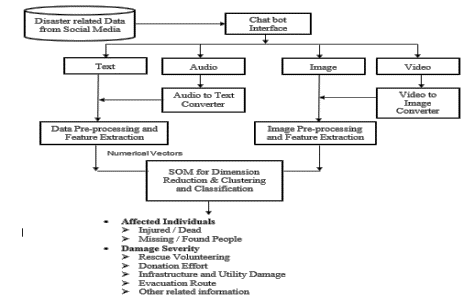An Ensemble Learning Approach for Fast Disaster Response using Social Media Analytics
Main Article Content
Abstract
Natural disaster happens, as a result of natural hazards that cause financial, environmental or human losses. Natural disasters strike unexpectedly, affecting the lives of tens of thousands of people. During the flood, social media sites were also heavily used to disseminate information about flooded areas, rescue agencies, food and relief centres. This work proposes an ensemble learning strategy for combining and analysing social media data in order to close the gap and progress in catastrophic situation. To enable scalability and broad accessibility of the dynamic streaming of multimodal data namely text, image, audio and video, this work is designed around social media data. A fusion technique was employed at the decision level, based on a database of 15 characteristics for more than 300 disasters around the world (Trained with MNIST dataset 60000 training images and 10000 testing images). This work allows the collected multimodal social media data to share a common semantic space, making individual variable prediction easier. Each merged numerical vector(tensors) of text and audio is sent into the K-CNN algorithm, which is an unsupervised learning algorithm (K-CNN), and the image and video data is given to a deep learning based Progressive Neural Artificial Search (PNAS). The trained data acts as a predictor for future incidents, allowing for the estimation of total deaths, total individuals impacted, and total damage, as well as specific suggestions for food, shelter and housing inspections. To make such a prediction, the trained model is presented a satellite image from before the accident as well as the geographic and demographic conditions, which is expected to result in a prediction accuracy of more than 85%.
Article Details
References
ECHO (2020). Shelter and settlements. Factsheet. European Civil Protection and Humanitarian Aid, Brussels
Oxfam (2016). The Effectiveness and Efficiency of Interventions Supporting Shelter Self-Recovery Following Humanitarian Crises: An evidence synthesis protocol. Humanitarian Evidence Program, London. 10.21201/2016.605179
Marmanis, D., Wegner, J. D., Galliani, S., Schindler, K., Datcu, M., & Stilla, U. (2016). Semantic segmentation of aerial images with an ensemble of CNSS. ISPRS Annals of the Photogrammetry, Remote Sensing and Spatial Information Sciences, 2016, 3, 473-480.
Warnier, M., Alkema, V., Comes, T., & Van de Walle, B. (2020). Humanitarian access, interrupted: dynamic near real-time network analytics and mapping for reaching communities in disaster-affected countries. OR Spectrum, 42(3), 815-834.
Simonyan, K., & Zisserman, A. (2014). Very deep convolutional networks for large-scale image recognition. arXiv preprint arXiv:1409.1556.
Chen, T., Lu, D., Kan, M.-Y., and Cui, P. (2013). “Understanding and classifying image tweets”. In: ACM International Conference on Multimedia, pp. 781–784.
Prof. Barry Wiling. (2018). Identification of Mouth Cancer laceration Using Machine Learning Approach. International Journal of New Practices in Management and Engineering, 7(03), 01 - 07. https://doi.org/10.17762/ijnpme.v7i03.66.
Socher, R., & Fei-Fei, L. (2010). Connecting modalities: Semi-supervised segmentation and annotation of images using unaligned text corpora. In 2010 IEEE Computer Society Conference on Computer Vision and Pattern Recognition
Chowdhury, S. A., Stepanov, E. A., Danieli, M., & Riccardi, G. (2019). Automatic classification of speech overlaps: Feature representation and algorithms. Computer Speech & Language, 55, 145-167.
Poria, S., Cambria, E., Howard, N., Huang, G. B., & Hussain, A. (2016). Fusing audio, visual and textual clues for sentiment analysis from multimodal content. Neuro computing, 174, 50-59.
Vande Berg, L. R., Wenner, L. A., & Gronbeck, B. E. (2004). Media literacy and television criticism: Enabling an informed and engaged citizenry. American Behavioral Scientist, 48(2), 219-228
Makarand L, M. . (2021). Earlier Detection of Gastric Cancer Using Augmented Deep Learning Techniques in Big Data with Medical Iot (Miot). Research Journal of Computer Systems and Engineering, 2(2), 22:26. Retrieved from https://technicaljournals.org/RJCSE/index.php/journal/article/view/28
A. Umamageswari, S. Deepa, K. Raja, “An enhanced approach for leaf disease identification andclassification using deep learning techniques”, Measurement: Sensors, Volume 24, 2022, 100568, ISSN2665-9174
Alvarez-Marin, D., & Ochoa, K. S. (2020). Indexical Cities: Articulating Personal Models of Urban Preference with Geotagged Data. arXiv preprint arXiv:2001.10615.
Ofli, F., Alam, F., & Imran, M. (2020). Analysis of social media data using multimodal deep learning for disaster response. arXiv preprint arXiv:2004.11838.
Pereira, M., Pádua, F., Pereira, A., Benevenuto, F., & Dalip, D. (2016, March). Fusing audio, textual, and visual features for sentiment analysis of news videos. In Proceedings of the International AAAI Conference on Web and Social Media
Umamageswari., Johnson, S.D., Sara, D., Kothandaraman, R. (2022). An enhanced identification andclassification algorithm for plant leaf diseases based on deep learning. Traitement du Signal, Vol. 39, No.3, pp. 1013-1018. https://doi.org/10.18280/ts.390328
Azlina Abdullah, Ismail Musirin, Muhammad Murtadha Othman, Siti Rafidah Abdul Rahim, A.V. Sentilkumar. (2023). Multi-DGPV Planning Using Artificial Intelligence. International Journal of Intelligent Systems and Applications in Engineering, 11(4s), 377–391. Retrieved from https://ijisae.org/index.php/IJISAE/article/view/2677.
Murtagh, F., & Hernández-Pajares, M. (1995). The Kohonen self-organizing map method: an assessment. Journal of Classification, 12(2)
Umamageswari A, Bharathiraja N, Irene DS. A Novel Fuzzy C-Means based Chameleon Swarm Algorithm for Segmentation and Progressive Neural Architecture Search for Plant Disease Classification.

